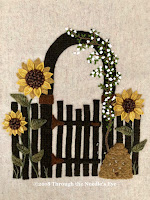So it's one of those weeks. Kara just got home from traveling to a family wedding and is dealing with jet lag, and I (Teri) am preparing to travel to Long Island to lecture and teach for a guild. So when we touched base this morning about what we should write, we thought it might be a perfect week to do a throwback to our most popular post. That post would be Marcia's Flowers—by far!
This was our very first pattern, and it continues to be a popular one. We are still teaching the class, and even occasionally getting to see some finished projects—always a real treat for us. Seeing projects based on our classes and patterns gives us great joy!
 |
| Last week at a workshop, Pat H. shared her Marcia's Flowers mat. The beads add a nice touch, and I love how she finished it with the scalloped edge! |
Thanks primarily to Pinterest, we are still getting lots of traffic on this original post. In light of our busy week creating writer's block, we thought we might make it easier for you to review. Enjoy!
💮💮💮💮💮💮💮💮💮💮💮💮💮💮💮💮💮💮💮💮💮💮💮💮
Thursday, September 15, 2016

In July, Kara shared The Story of an Inspiring Jacket with you. Today, I (Teri) will show you what we have each done with the design created from that jacket. These projects have been such fun, and we hope to share the joy with you. We are excited to teach this class at Primitive Homespuns Wool & Needleworks in October, in Frederick, MD.
When we first met Kathy, the owner of the shop, she asked if we could design a wool appliqué piece that could be used to top a wooden box. Kara had already started working on this pattern in bright colors by Shakerwood Woolens, and we took it in to show to her. Kathy thought that the design would be perfect, so I selected a palette of colors from her shop to stitch my model. As I love warm colors, my model has a very different look from Kara's. Our two examples show how the same pattern, with the same embroidery stitches, can look so very different!
Here are a few side-by-side detail shots for you to compare.




Sometimes a different look is achieved because of different thread choices, or even because of the density and weave of the wool. The purple wool on the outer petal of the above flower, left, held the scalloped cut. The teal, on the right, however, was a looser weave, so I chose to fray it with the back of my needle, so it would look more feathery.


For our class at Primitive Homespuns, we will be using the warmer palette and making a lovely box that would be perfect for storing sewing supplies, threads, or even used as a project box for appliqué or embroidery pieces. I went to the shop yesterday to work with Kathy to secure the finished piece on the top of the box, which she had painted a lovely brick red. First, I backed the finished piece with muslin, using SoftFuse Premium™ as my fusible. Then I trimmed it to size, and we backed it with Shurtape® double-sided carpet tape. Kathy has this process down to an art; I was impressed watching her trim the tape to the size of the appliqué, and methodically remove one strip of backing paper at a time to carefully secure it to the box with proper placement.

We auditioned several examples of trim, including discussing a blanket stitch around the edge of the block, but we settled on a lovely vintage chenille yarn, which we glued down using Aleene's® Original Tacky Glue®. The color matched the pale yellow used in the block and gave it a nice, finished look without distracting the eye from the design.
While I was stitching up my model, I put a photo of my embroidery on a Facebook group and was astonished by the number of requests there were for the pattern. So we decided that it only made sense to write up directions and create a formal pattern. We have been working hard to get it ready, and it should be up on our website by October. But in the meantime, if you live in the Frederick area of Maryland, come join us for some Saturday fun! (For more information about the class, please check our website, by clicking here.)*
We thought it would be fun to put our two projects together for a photo session; here they are sitting on a chair together in the shop. You can see that Kara decided to stitch hers into a pillow, and she just happened to have the perfect fabric to match her appliqué! What would we do without such an extensive fabric stash?!
 |
| Marcia's Flowers |
💮💮💮💮💮💮💮💮💮💮💮💮💮💮💮💮💮💮💮💮💮💮💮💮
*NOTE: We don't happen to currently have a class scheduled for this block, but if there is interest, we can always add one! And, for the record, the patterns ARE now available on our website, in both digital and hard copy!
Have a wonderful weekend, everyone!!
Have a wonderful weekend, everyone!!








































